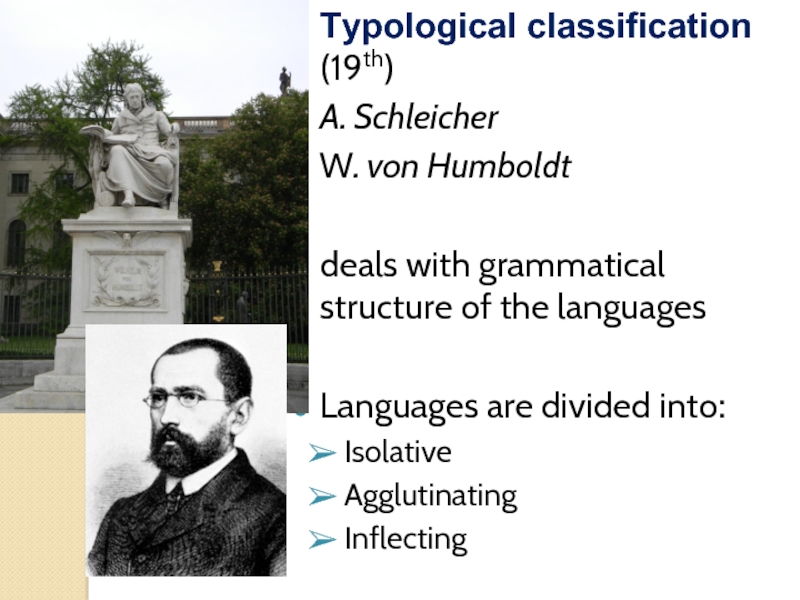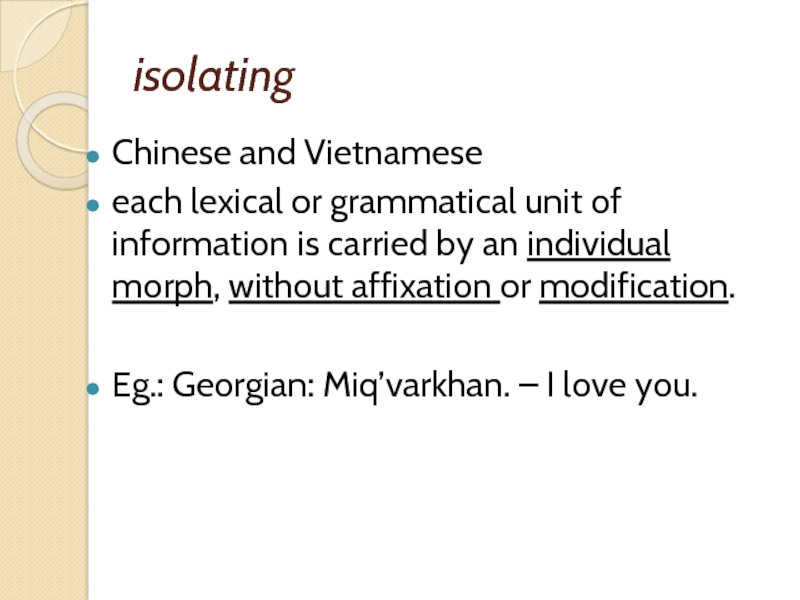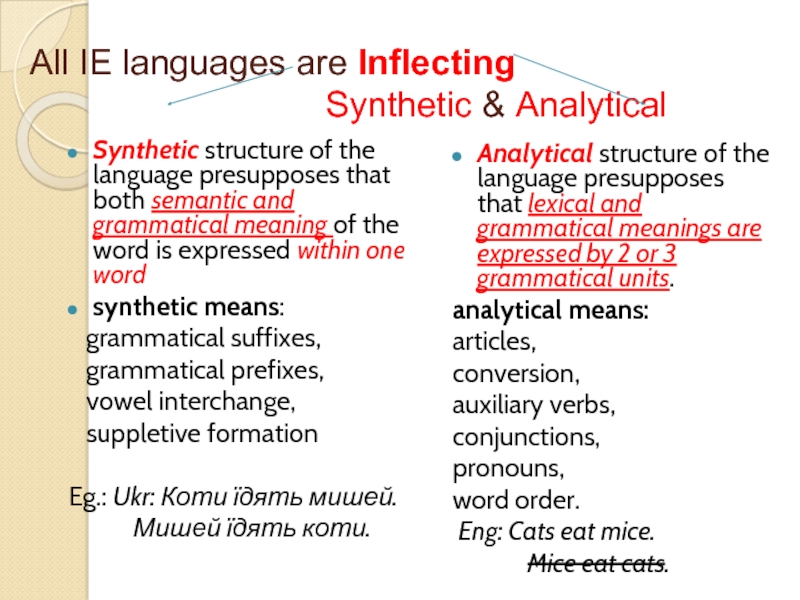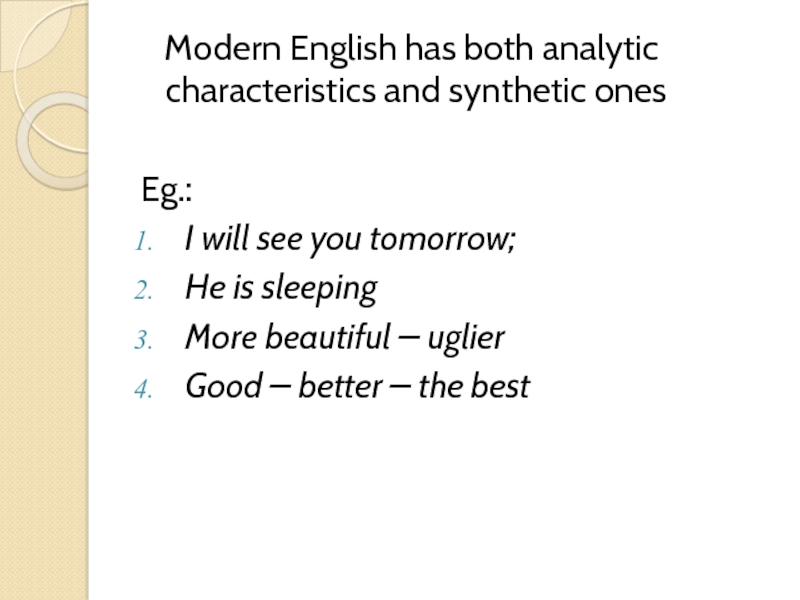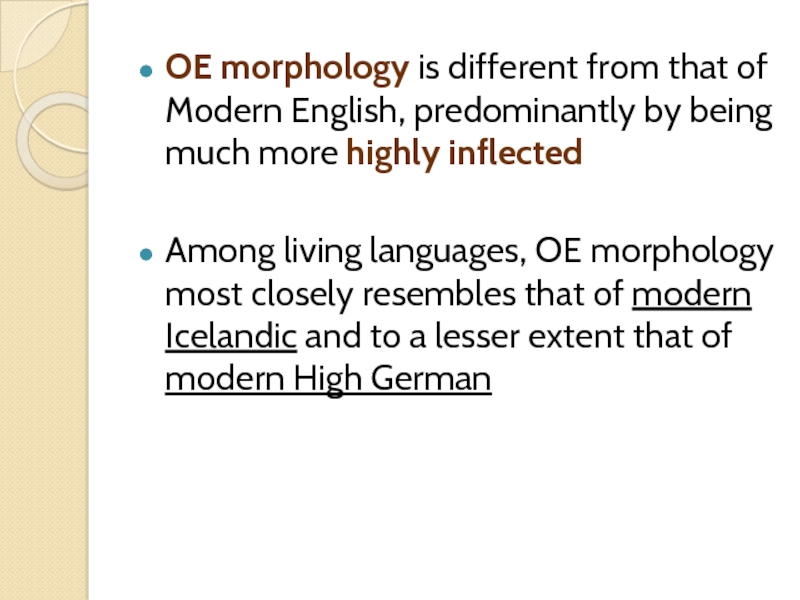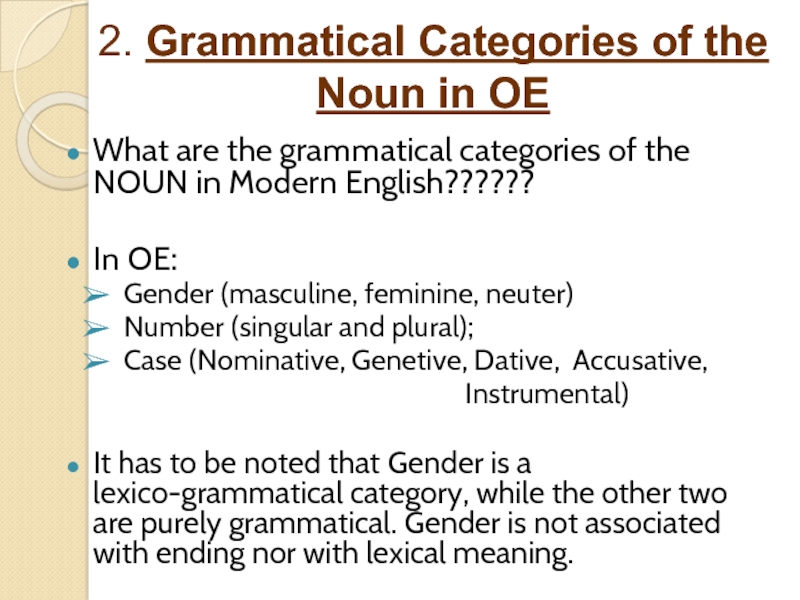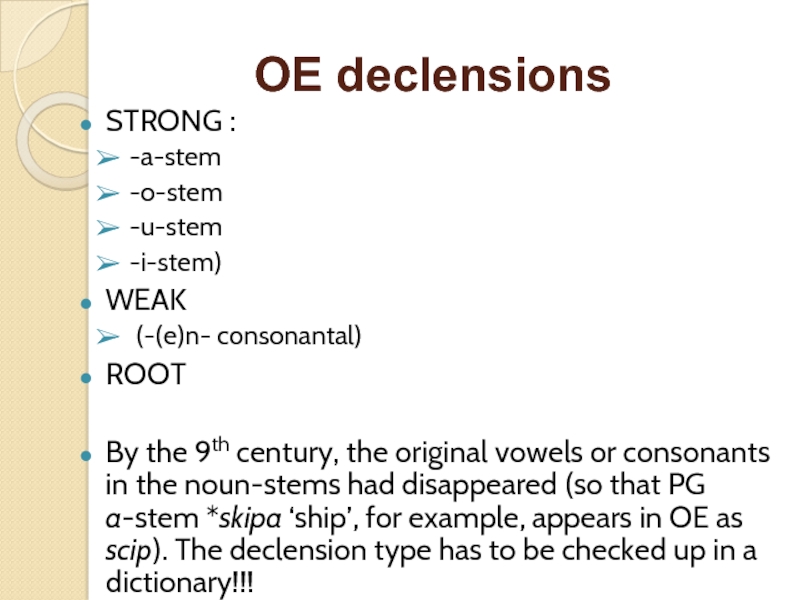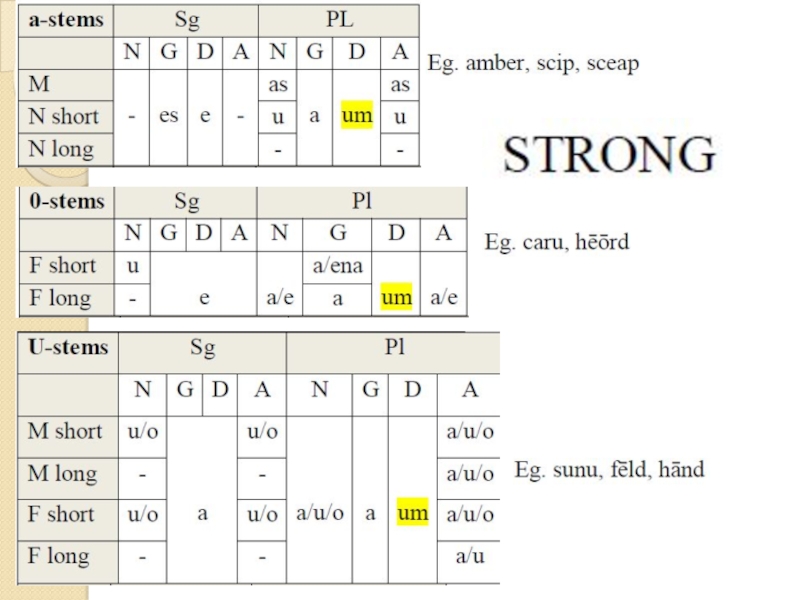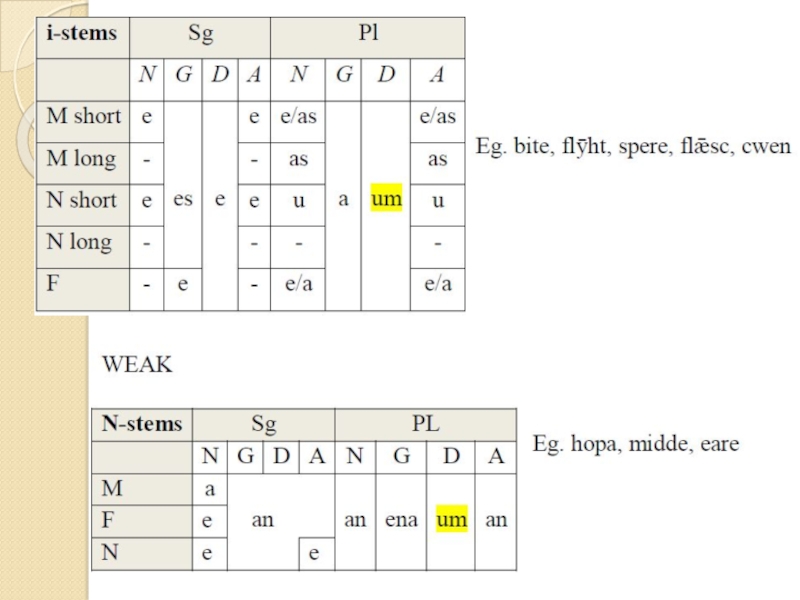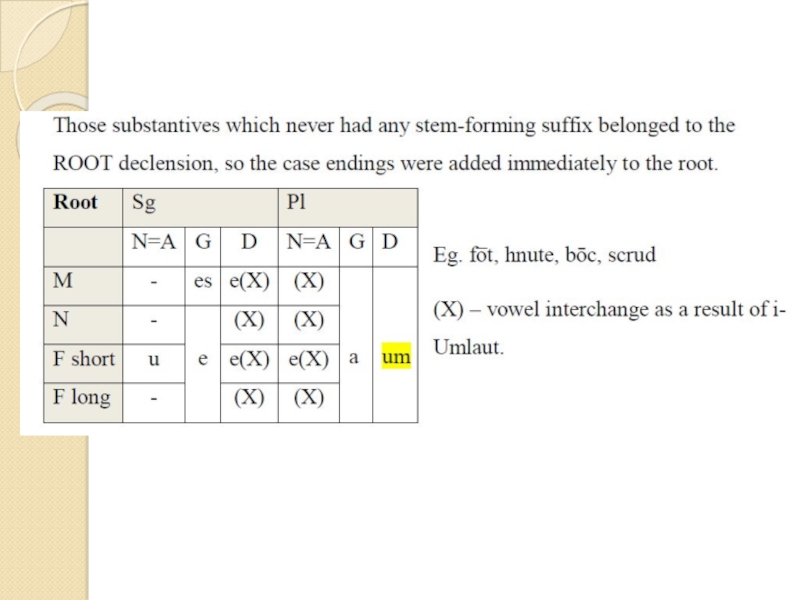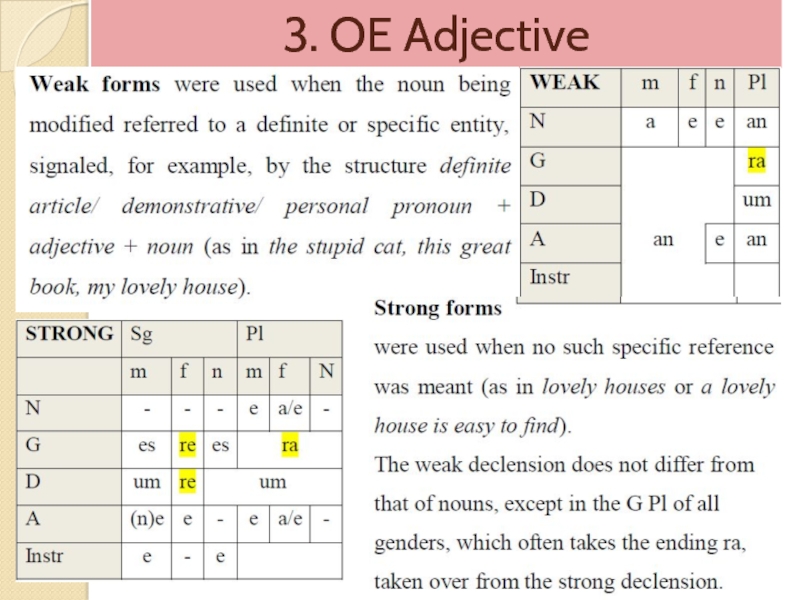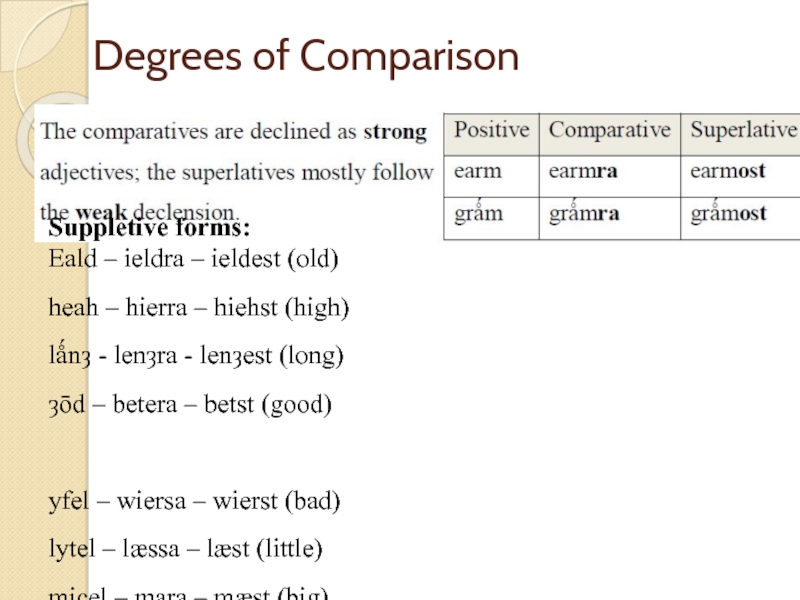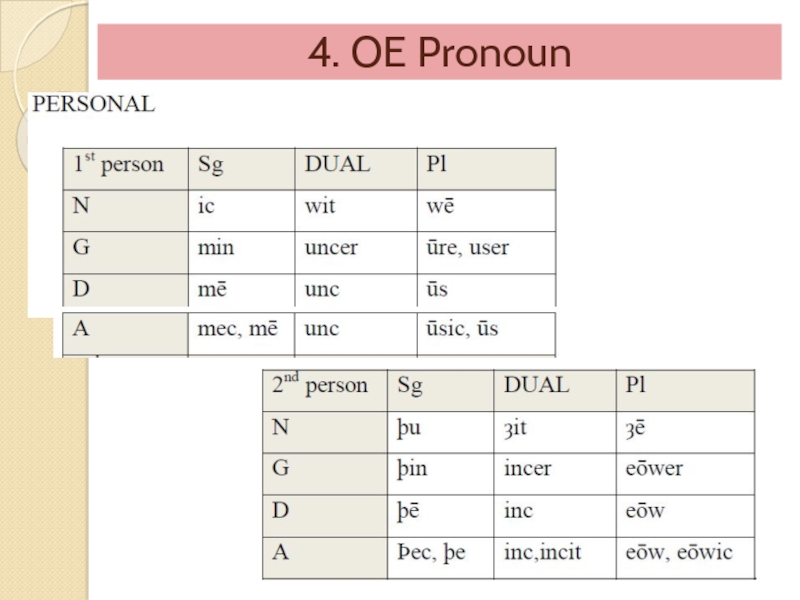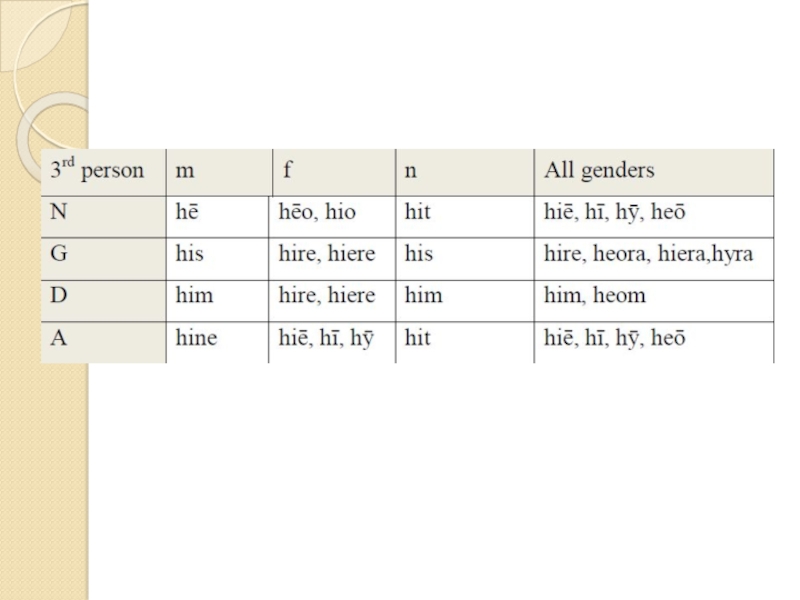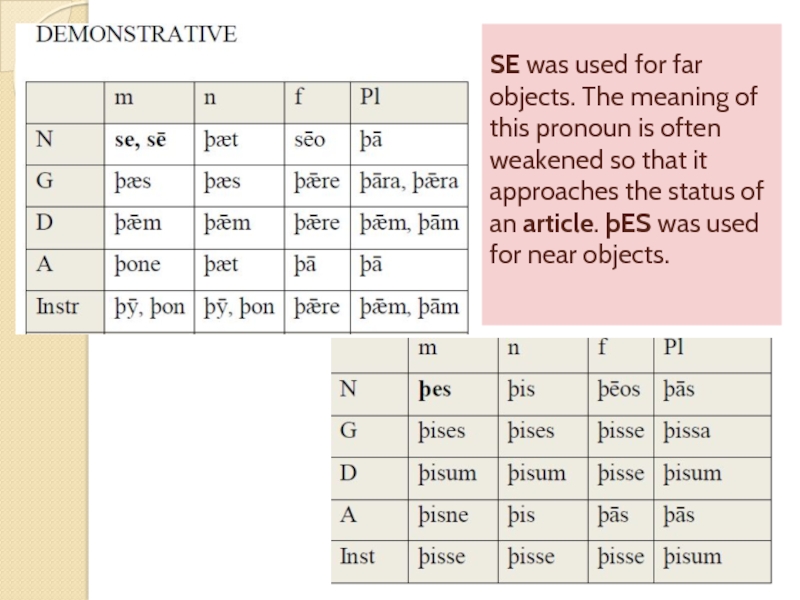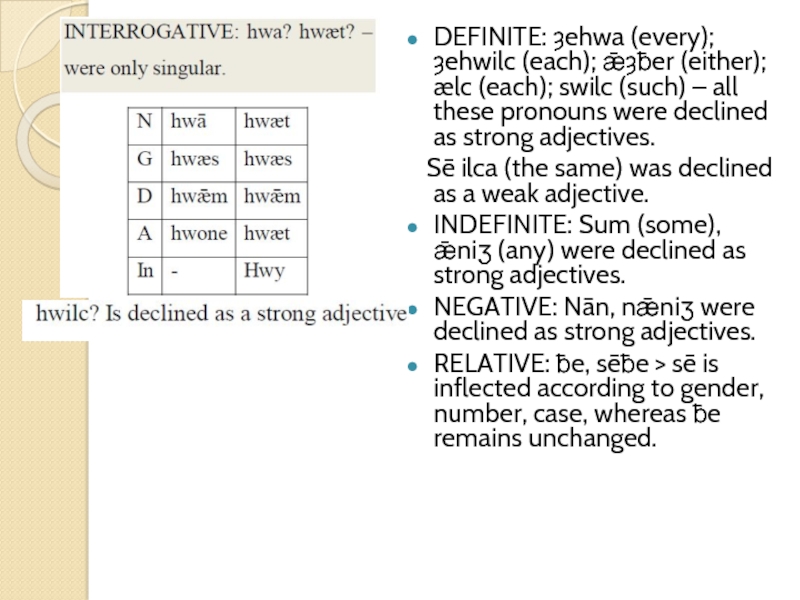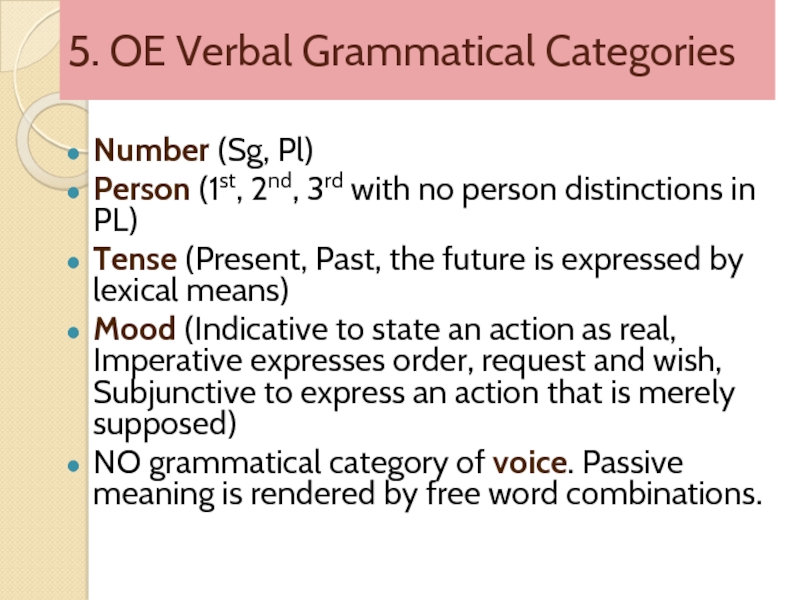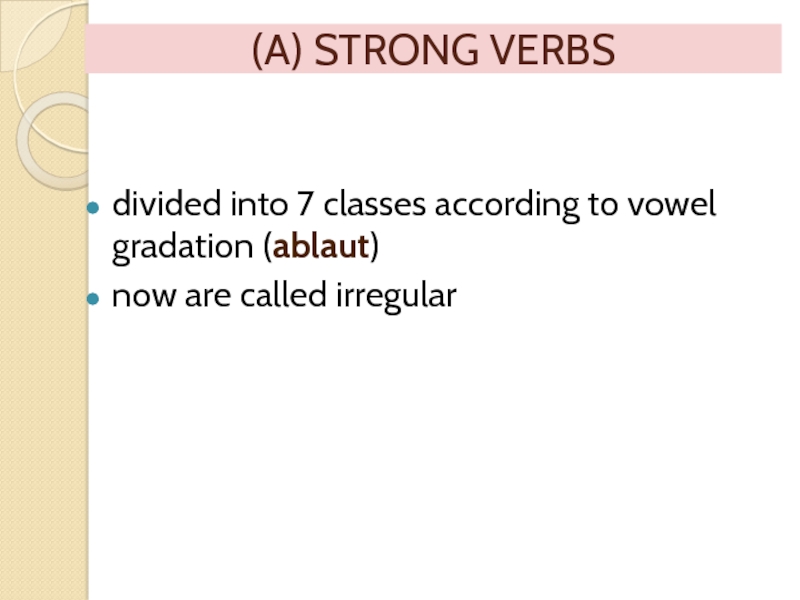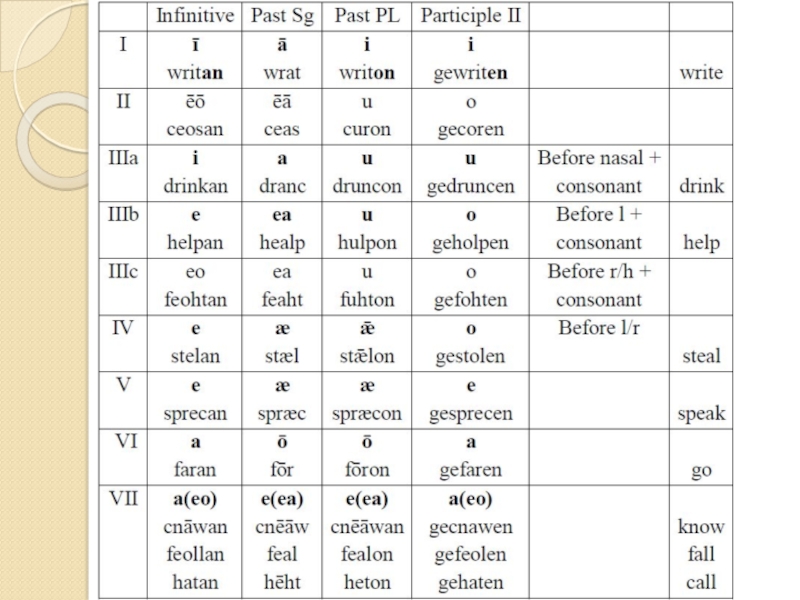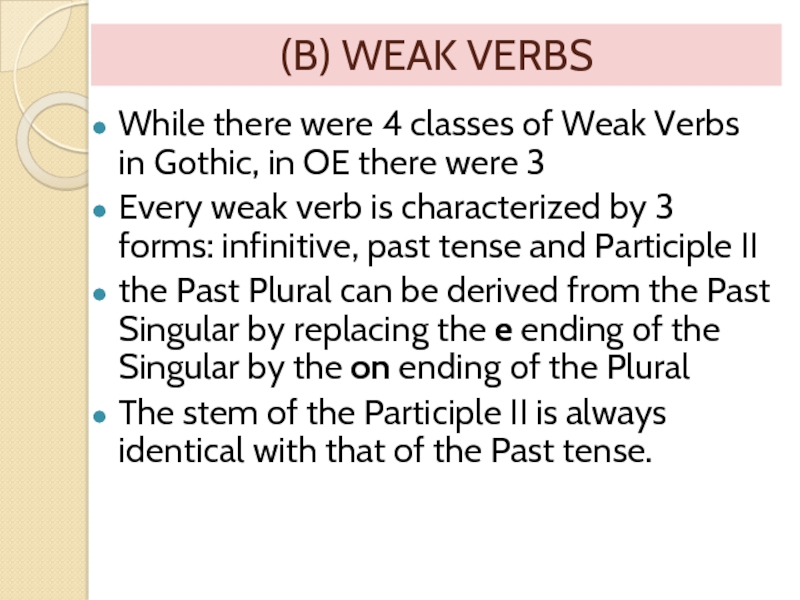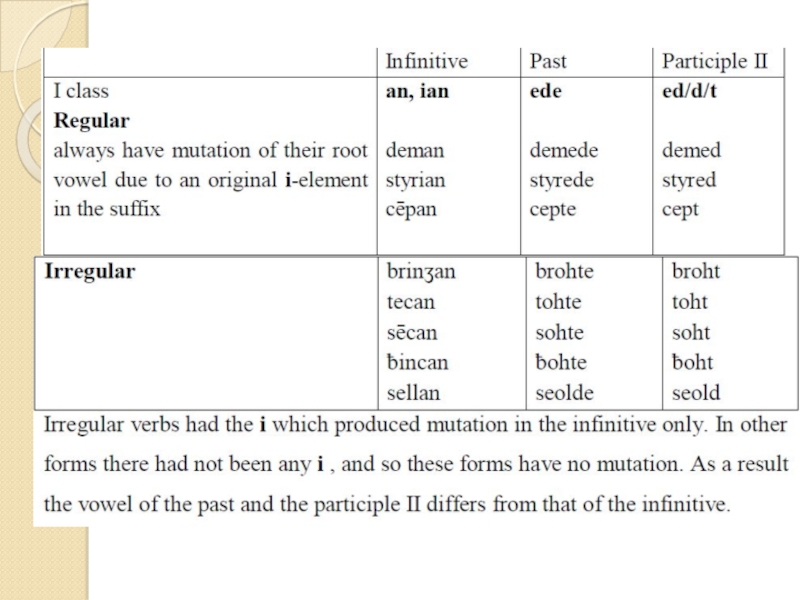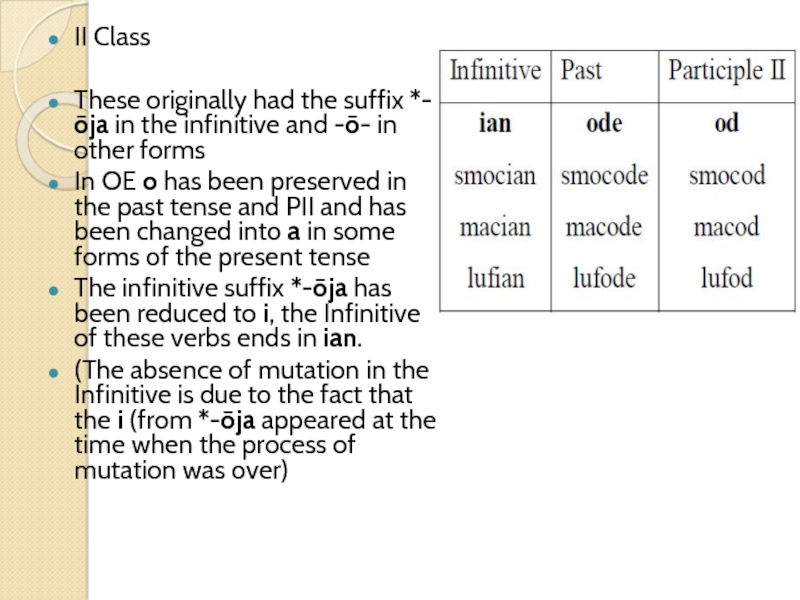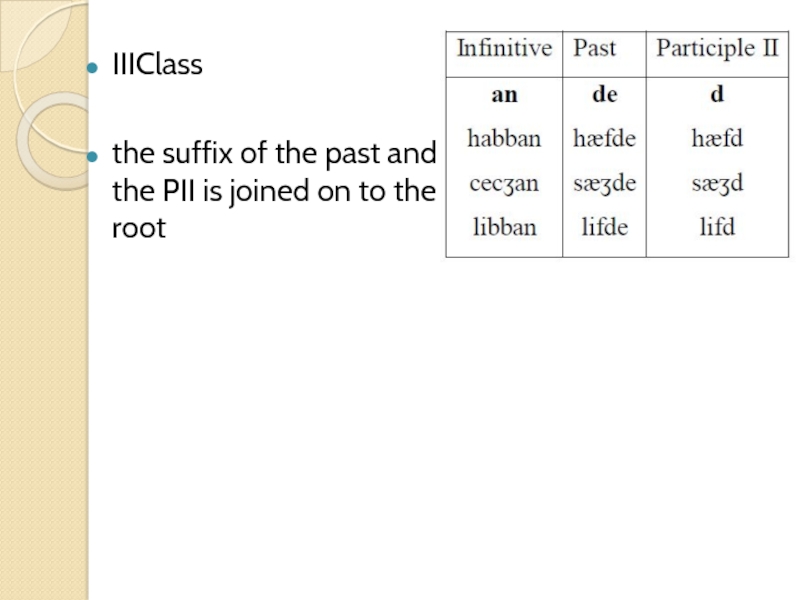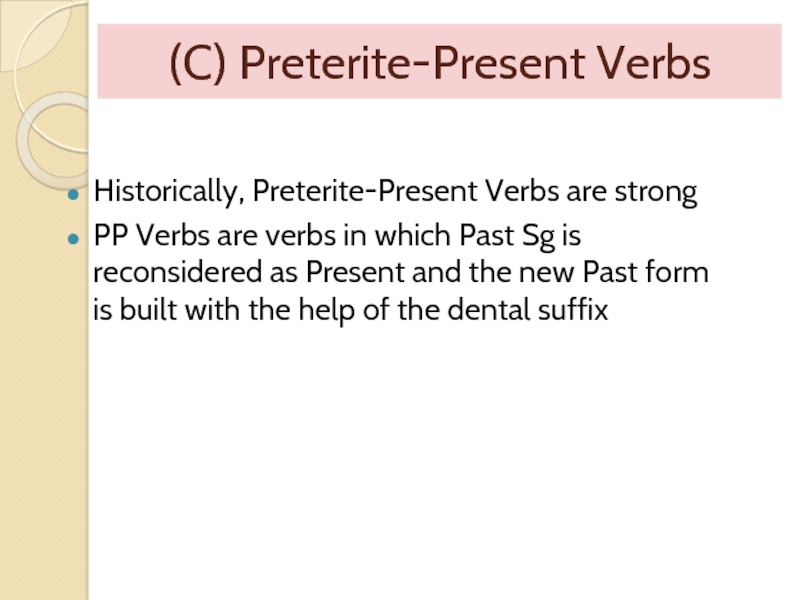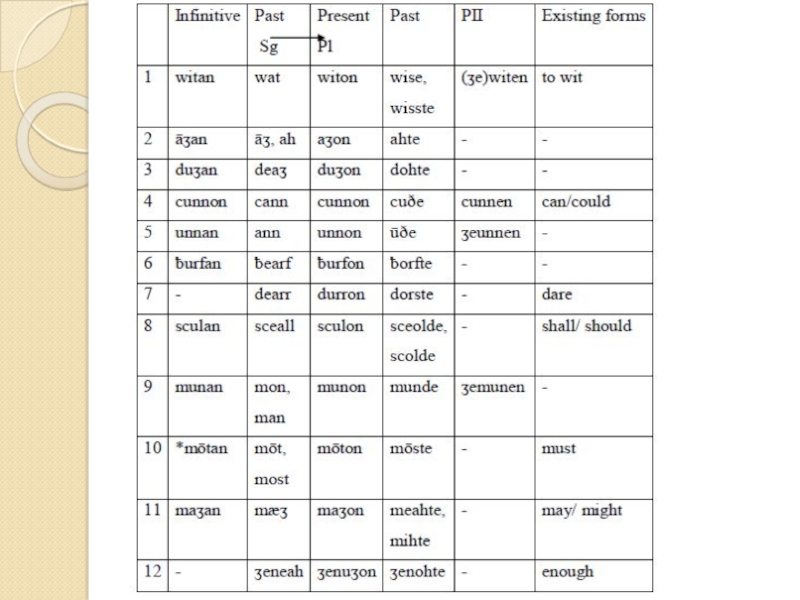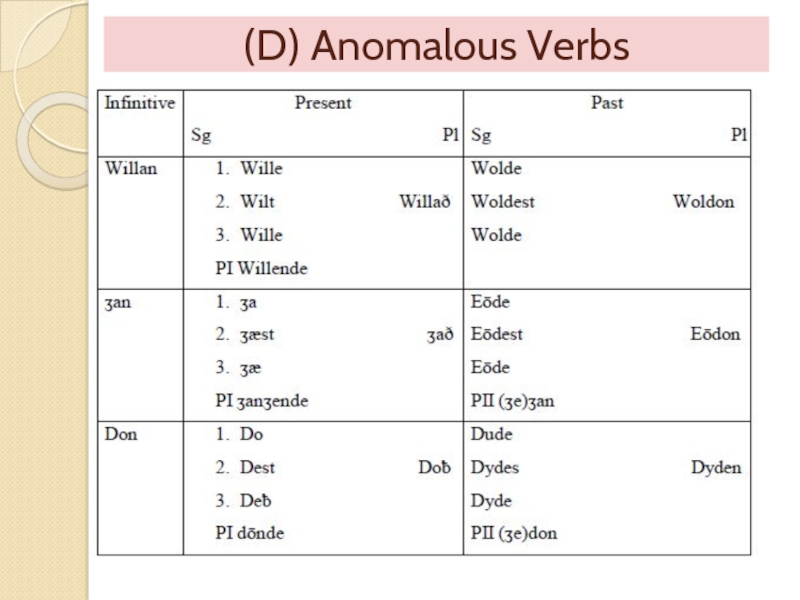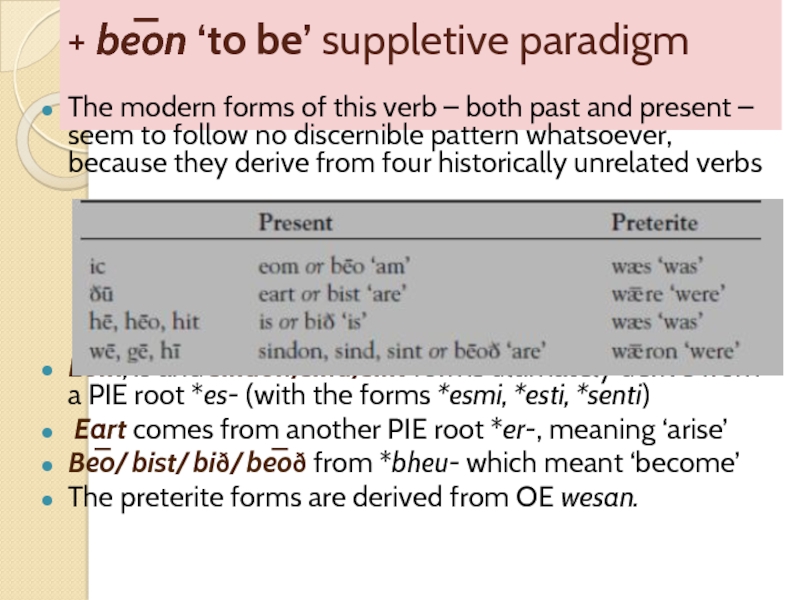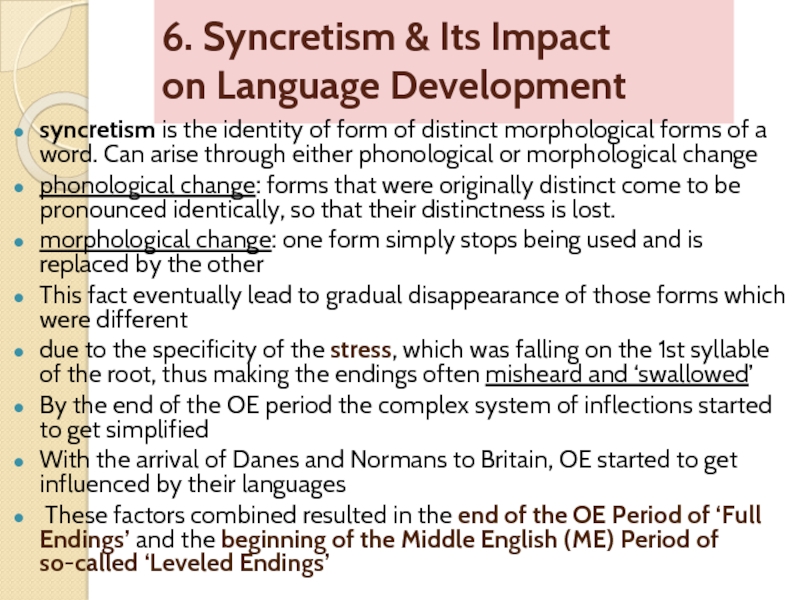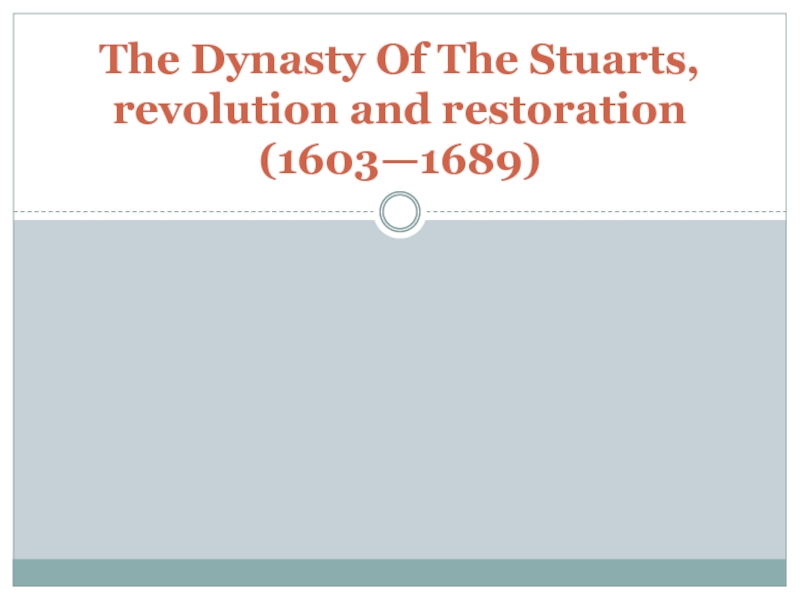- Главная
- Разное
- Дизайн
- Бизнес и предпринимательство
- Аналитика
- Образование
- Развлечения
- Красота и здоровье
- Финансы
- Государство
- Путешествия
- Спорт
- Недвижимость
- Армия
- Графика
- Культурология
- Еда и кулинария
- Лингвистика
- Английский язык
- Астрономия
- Алгебра
- Биология
- География
- Детские презентации
- Информатика
- История
- Литература
- Маркетинг
- Математика
- Медицина
- Менеджмент
- Музыка
- МХК
- Немецкий язык
- ОБЖ
- Обществознание
- Окружающий мир
- Педагогика
- Русский язык
- Технология
- Физика
- Философия
- Химия
- Шаблоны, картинки для презентаций
- Экология
- Экономика
- Юриспруденция
OE Morphology презентация
Содержание
- 1. OE Morphology
- 2. Typological classification (19th) A. Schleicher W.
- 3. isolating Chinese and Vietnamese each lexical or
- 4. agglutinating Turkish morphs are ‘stuck’ together
- 5. All IE languages are Inflecting
- 6. Modern English has both analytic
- 7. OE morphology is different from that of
- 8. 2. Grammatical Categories of the Noun in
- 9. OE declensions STRONG : -a-stem -o-stem
- 13. 3. OE Adjective
- 14. Degrees of Comparison Suppletive forms: Eald –
- 15. 4. OE Pronoun
- 17. SE was used for far objects. The
- 18. DEFINITE: ȝehwa (every); ȝehwilc (each); ǣȝƀer (either);
- 19. 5. OE Verbal Grammatical Categories Number (Sg,
- 20. (A) STRONG VERBS divided into
- 22. (B) WEAK VERBS While there were 4
- 24. II Class These originally had the
- 25. IIIClass the suffix of the past
- 26. (C) Preterite-Present Verbs Historically, Preterite-Present Verbs are
- 28. (D) Anomalous Verbs
- 29. + be̅on ‘to be’ suppletive paradigm
- 30. 6. Syncretism & Its Impact
Слайд 2Typological classification (19th)
A. Schleicher
W. von Humboldt
deals with grammatical structure of
Languages are divided into:
Isolative
Agglutinating
Inflecting
Слайд 3isolating
Chinese and Vietnamese
each lexical or grammatical unit of information is carried
Eg.: Georgian: Miq’varkhan. – I love you.
Слайд 4agglutinating
Turkish
morphs are ‘stuck’ together to form words. Each morph has
Слайд 5All IE languages are Inflecting
Synthetic structure of the language presupposes that both semantic and grammatical meaning of the word is expressed within one word
synthetic means:
grammatical suffixes,
grammatical prefixes,
vowel interchange,
suppletive formation
Eg.: Ukr: Коти їдять мишей.
Мишей їдять коти.
Analytical structure of the language presupposes that lexical and grammatical meanings are expressed by 2 or 3 grammatical units.
analytical means:
articles,
conversion,
auxiliary verbs,
conjunctions,
pronouns,
word order.
Eng: Cats eat mice.
Mice eat cats.
Слайд 6 Modern English has both analytic characteristics and synthetic ones
Eg.:
I will see you tomorrow;
He is sleeping
More beautiful – uglier
Good – better – the best
Слайд 7OE morphology is different from that of Modern English, predominantly by
Among living languages, OE morphology most closely resembles that of modern Icelandic and to a lesser extent that of modern High German
Слайд 82. Grammatical Categories of the Noun in OE
What are the grammatical
In OE:
Gender (masculine, feminine, neuter)
Number (singular and plural);
Case (Nominative, Genetive, Dative, Accusative,
Instrumental)
It has to be noted that Gender is a lexico-grammatical category, while the other two are purely grammatical. Gender is not associated with ending nor with lexical meaning.
Слайд 9OE declensions
STRONG :
-a-stem
-o-stem
-u-stem
-i-stem)
WEAK
(-(e)n- consonantal)
ROOT
By the 9th century, the original
Слайд 14Degrees of Comparison
Suppletive forms:
Eald – ieldra – ieldest (old)
heah – hierra
lǻnȝ - lenȝra - lenȝest (long)
ȝōd – betera – betst (good)
yfel – wiersa – wierst (bad)
lytel – læssa – læst (little)
micel – mara – mæst (big)
Слайд 17SE was used for far objects. The meaning of this pronoun
Слайд 18DEFINITE: ȝehwa (every); ȝehwilc (each); ǣȝƀer (either); ælc (each); swilc (such)
Sē ilca (the same) was declined as a weak adjective.
INDEFINITE: Sum (some), ǣniʒ (any) were declined as strong adjectives.
NEGATIVE: Nān, nǣniʒ were declined as strong adjectives.
RELATIVE: ƀe, sēƀe > sē is inflected according to gender, number, case, whereas ƀe remains unchanged.
Слайд 195. OE Verbal Grammatical Categories
Number (Sg, Pl)
Person (1st, 2nd, 3rd with
Tense (Present, Past, the future is expressed by lexical means)
Mood (Indicative to state an action as real, Imperative expresses order, request and wish, Subjunctive to express an action that is merely supposed)
NO grammatical category of voice. Passive meaning is rendered by free word combinations.
Слайд 20(A) STRONG VERBS
divided into 7 classes according to vowel gradation (ablaut)
now
Слайд 22(B) WEAK VERBS
While there were 4 classes of Weak Verbs in
Every weak verb is characterized by 3 forms: infinitive, past tense and Participle II
the Past Plural can be derived from the Past Singular by replacing the e ending of the Singular by the on ending of the Plural
The stem of the Participle II is always identical with that of the Past tense.
Слайд 24II Class
These originally had the suffix *-ōja in the infinitive and
In OE o has been preserved in the past tense and PII and has been changed into a in some forms of the present tense
The infinitive suffix *-ōja has been reduced to i, the Infinitive of these verbs ends in ian.
(The absence of mutation in the Infinitive is due to the fact that the i (from *-ōja appeared at the time when the process of mutation was over)
Слайд 26(C) Preterite-Present Verbs
Historically, Preterite-Present Verbs are strong
PP Verbs are verbs in
Слайд 29+ be̅on ‘to be’ suppletive paradigm
The modern forms of this verb
Eom, is and sindon/sind/sint forms ultimately derive from a PIE root *es- (with the forms *esmi, *esti, *senti)
Eart comes from another PIE root *er-, meaning ‘arise’
Be̅o/ bist/ bið/ be̅oð from *bheu- which meant ‘become’
The preterite forms are derived from OE wesan.
Слайд 30
6. Syncretism & Its Impact
on Language Development
syncretism is the identity
phonological change: forms that were originally distinct come to be pronounced identically, so that their distinctness is lost.
morphological change: one form simply stops being used and is replaced by the other
This fact eventually lead to gradual disappearance of those forms which were different
due to the specificity of the stress, which was falling on the 1st syllable of the root, thus making the endings often misheard and ‘swallowed’
By the end of the OE period the complex system of inflections started to get simplified
With the arrival of Danes and Normans to Britain, OE started to get influenced by their languages
These factors combined resulted in the end of the OE Period of ‘Full Endings’ and the beginning of the Middle English (ME) Period of so-called ‘Leveled Endings’

